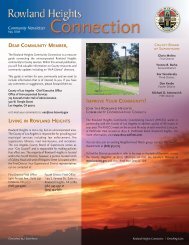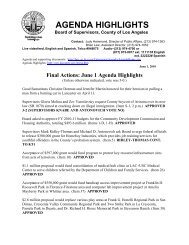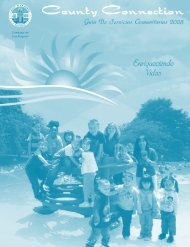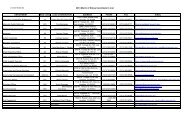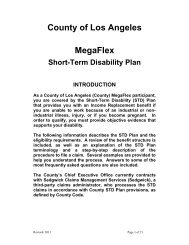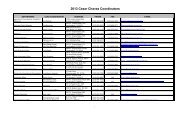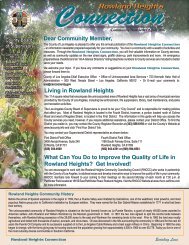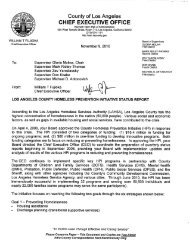assessing the transportation needs of welfare-to-work participants in ...
assessing the transportation needs of welfare-to-work participants in ...
assessing the transportation needs of welfare-to-work participants in ...
You also want an ePaper? Increase the reach of your titles
YUMPU automatically turns print PDFs into web optimized ePapers that Google loves.
Ano<strong>the</strong>r limitation <strong>in</strong>troduced by <strong>the</strong> use <strong>of</strong> supplemental <strong>in</strong>formation was that <strong>the</strong> GEARS<br />
database did not provide a case name. The case name used for surveys was derived from <strong>the</strong><br />
FOCUS database ma<strong>in</strong>ta<strong>in</strong>ed by DPSS, which <strong>in</strong>dicates <strong>the</strong> <strong>of</strong>ficial person designated <strong>to</strong> conduct<br />
<strong>the</strong> bus<strong>in</strong>ess <strong>of</strong> <strong>the</strong> <strong>welfare</strong> case with DPSS. The case name used for survey<strong>in</strong>g purposes was<br />
derived from a different source than <strong>the</strong> case phone numbers. Therefore, some sampled cases<br />
with phone numbers did not have a case name and vise versa. Ano<strong>the</strong>r issue regard<strong>in</strong>g case<br />
names <strong>in</strong>volved <strong>the</strong> disproportionate presence <strong>of</strong> female case names, even for two-parent (U)<br />
cases <strong>in</strong> which a male is usually present <strong>in</strong> <strong>the</strong> household. Therefore, when <strong>in</strong>terviewers were<br />
contact<strong>in</strong>g two-parent (U) families, <strong>the</strong>y were disproportionately survey<strong>in</strong>g <strong>the</strong> woman<br />
associated with <strong>the</strong> case. Although <strong>the</strong> oldest person on cases sampled was approximately 15%<br />
male (based on FOCUS data), <strong>the</strong> <strong>in</strong>itial male response rate was considerably lower.<br />
Adjustments were made <strong>to</strong> <strong>the</strong> survey<strong>in</strong>g process <strong>to</strong> compensate for this limitation (described <strong>in</strong><br />
<strong>the</strong> “Survey Implementation” section below).<br />
To respond <strong>to</strong> <strong>the</strong> low male response rate <strong>in</strong>troduced by <strong>the</strong> fact that case names are<br />
disproportionately female, 100 supplemental <strong>in</strong>terviews <strong>of</strong> two-parent (U aid type) cases were<br />
conducted <strong>to</strong> <strong>in</strong>crease <strong>the</strong> male response rate. The UCLA Lewis Center sampled additional cases<br />
and funded <strong>the</strong> supplemental <strong>in</strong>terviews, which targeted two-parent (U) cases because males are<br />
most prevalent <strong>in</strong> this type <strong>of</strong> <strong>welfare</strong> case. The process <strong>of</strong> sampl<strong>in</strong>g additional two-parent (U)<br />
cases for <strong>the</strong>se <strong>in</strong>terviews resulted <strong>in</strong> an overall CTNA sample that conta<strong>in</strong>s a disproportionately<br />
large number <strong>of</strong> two-parent (U) cases (described <strong>in</strong> more detail below). Also, <strong>the</strong> sample drawn<br />
for <strong>the</strong>se additional 100 supplemental <strong>in</strong>terviews were not geocoded and assigned a supervisorial<br />
district s<strong>in</strong>ce <strong>the</strong> first wave <strong>of</strong> 1545 <strong>in</strong>terview adequately represented all districts.<br />
Description <strong>of</strong> Stratified Random Sample<br />
The follow<strong>in</strong>g describes <strong>the</strong> randomly sampled GAIN cases with regard <strong>to</strong> <strong>the</strong> data limitations<br />
described above:<br />
Initial random sample: 19,996 (100%)<br />
Cases with addresses: 15,595 (78%)<br />
Estimated cases with valid residential phone number: 12,629 (63%)<br />
Total completed surveys: 1,645 (8%)<br />
Despite <strong>the</strong> limitations <strong>in</strong> data and contact <strong>in</strong>formation described above, <strong>the</strong> overall randomness<br />
<strong>of</strong> <strong>the</strong> sample and survey were preserved. As shown <strong>in</strong> Table 1, <strong>the</strong> composition <strong>of</strong> <strong>the</strong> sample<br />
population and f<strong>in</strong>al survey respondents is representative <strong>of</strong> <strong>the</strong> entire GAIN population. There<br />
are slight differences, primarily <strong>in</strong> terms <strong>of</strong> household aid type and case primary language, which<br />
can largely be attributed <strong>to</strong> <strong>the</strong> over-sampl<strong>in</strong>g <strong>of</strong> two-parent (U) cases <strong>to</strong> <strong>in</strong>crease <strong>the</strong> male<br />
response rate. The over-sampl<strong>in</strong>g <strong>of</strong> two-parent cases may also expla<strong>in</strong> <strong>the</strong> observed differences<br />
<strong>in</strong> primary language. Non-English cases are more prevalent among two-parent (U) cases. S<strong>in</strong>ce<br />
U cases are over-represented among survey respondents, survey tabulations for this report are<br />
weighted <strong>in</strong> order <strong>to</strong> assure that that tabulations are representative <strong>of</strong> <strong>the</strong> <strong>welfare</strong> <strong>to</strong> <strong>work</strong><br />
population <strong>in</strong> Los Angeles County (as described <strong>in</strong> more detail below).<br />
3






